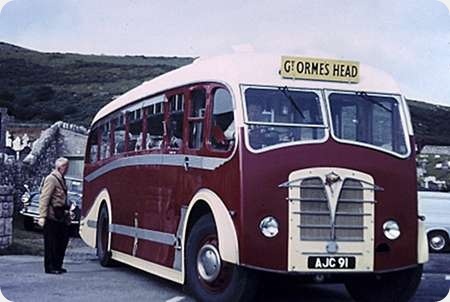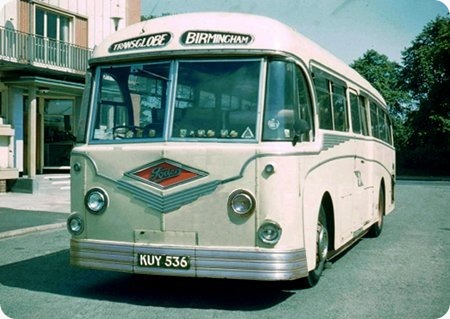
Copyright N Edwards.
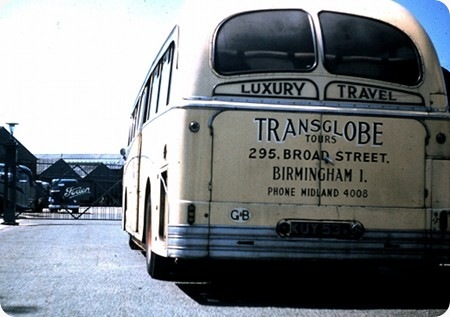
Copyright N Edwards.
Transglobe Tours
1952
Foden PVRF6
Metalcraft C41C
The above two shots of a Foden PVR with Fodens own two-stroke engine were taken in my ‘Transglobe’
driving days. I had taken it to the Foden works at Sandbach Cheshire for an annoying fuel pump fault –
as I remember, apart from being noisy animals, these were very temperamental – constant adjustments to
fuel delivery points (pump and injectors) being the order of the day. Although I never did a continental
trip with this coach, I had one continental trip with a Bedford SBG Seagull that gave me quite a hard
time ending with its brakes finally burning out on a very steep section in the Austrian Alps. The Church
party and myself being returned to the French coast by a superior German coach, a ‘Satra’, as I
recall.
My thanks to Mike Beamish/www.mikesbuspages.co uk for allowing me to use a couple of
his photos so that you can see offside views of a similar Metalcraft Foden PVR to the above.
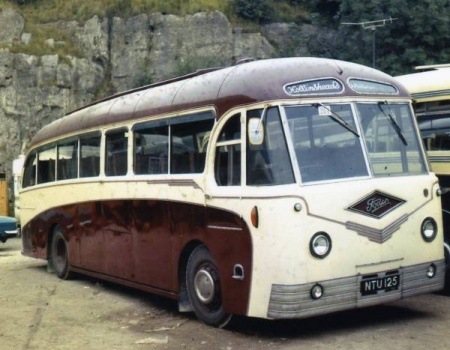
Mike Beamish.
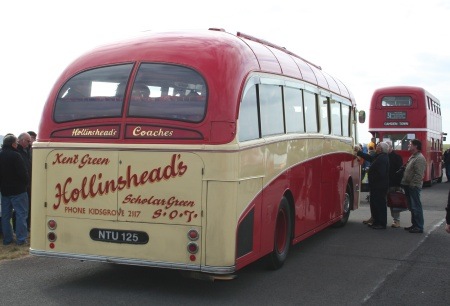
Mike Beamish.
According to Mike NTU 125 had been repainted in deeper Cream with a brighter Red relief than the first
time he took a shot of it. The last of these two shots shows it at the Buses 60 Rally at Wroughton when
it was being used to transport visitors to the various hangars and exhibition areas.
Photographs and Copy contributed by Nigel Edwards
Perhaps returned to the coast by a Kassborer-SETRA - now just Setra: and still
very good. Rear engine…. quiet, comfortable: why isn’t it Foden?
Joe
Why isn’t it Foden? Setra have spent the last 50 years developing into the
leading coach builder of Europe - if not the world. Foden chose to abandon PSVs and concentrate on
HGVs - especially specialist applications.
Given a different history, who knows? Foden quality
was never in doubt. Foden and AEC could both have become as well regarded today as Setra - they
simply didn’t survive (for historical reasons that most of us already know).
David Oldfield
03/02/11 - 10:36
Nigel Edwards’ recollections of driving this coach to Fodens for adjustments
are fascinating. Transglobe operated the coach between February 1958 and September 1959, if my
records are correct. I can confirm that it definitely had a Metalcraft body. The Foden two-stoke
engine was, I believe, fairly complex - and probably misunderstood. Some companies seemed to like
them, others just did not get on with them. Cook’s Coaches from Lyneham in Wiltshire at one point
had three two-stroke engined Fodens ….. in their fleet of three! The Whenuapai Bus Company and
City Bus Services in New Zealand, however, had no end of troubles with their quintet, but once
Hawkes’ Bay Bus Company bought up the bankrupt City B S along with the Fodens and had them properly
overhauled, they found that the engine fan had been repositioned to accommodate the bodywork. Once
the fans were correctly positioned, and also once they had a Foden-trained mechanic looking after
them, they went on to give many years of reliable service. The last one wasn’t taken out of service
until June 1980, later than some Leyland Royal Tigers in the same fleet. All five went on to serve
as movans (mobile homes) and two still exist in such a capacity even now, though one is effectively
immobile.
Peter Tulloch
16/01/13 - 13:40
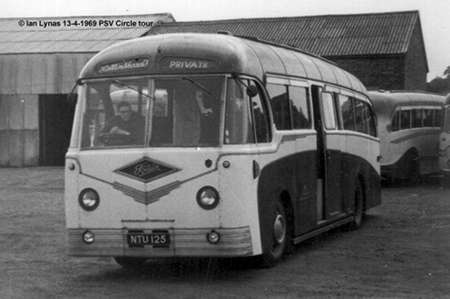
Copyright Ian Lynas
I (and probably 50 or so other enthusiasts) took this shot of NTU 125, a
rear-engined Foden with Metalcraft coachwork belonging to Hollinsheads of Scholar Green in Cheshire
during a PSV Circle Manchester tour on 13th April 1969. Fantastic tour which brought out Fodens from
every nook and cranny. I think the tour was organised by the late Peter Roberts.
Ian Lynas
17/01/13 - 05:24
As far as I know Peter Roberts is still with us! Hardly any bus enthusiasts in
the Manchester area doesn’t know of him, remembering with affection the PSV Circle meetings which
still continue today, but I particularly remember the halcyon days of the late ‘sixties/early
seventies (when Ian was there too!). They were in the Briton’s Protection hotel overlooking Lower
Mosley Street and always very popular.
David Beilby
17/01/13 - 11:50
Can anybody lend me some photographs from this visit to Hollinshead’s (or scan
them for me at 300 dpi or better)? I’m currently working on a book about Northwest independents and
prints of their (pre 1970) vehicles have proven surprisingly hard to find. Weirdly, I’ve never
knowingly met Peter Roberts although for several years I lived on Dane Road in Sale - virtually
around the corner! I am of course familiar with his reputation as an outstanding photographer.
Help?
Neville Mercer
23/01/13 - 13:16
My apologies to Peter Roberts. Good to hear he is still around and if you keep
contact with him, thank him for the meetings which had a good smattering of everything, an ability
to talk to like-minded enthusiasts, a quick formal part, great slide presentation and lots of info
about what was going on in the local bus world. Thanks also David, I might have to reward you with a
picture of your good self and others with Southport Crossley 116.
to Neville Mercer, I only
took one other shot at Hollinsheads of a fairly new Duple Dominant, GTU 119G. It is already scanned
at 300 dpi at 3008 x 2000. Any good Neville.
Ian Lynas
24/01/13 - 11:08
The Dominant is a bit new for my tastes, Ian, and would have been delivered
after Hollinshead’s stage service ended. I would like a scan of your shot of NTU 125 though - I
already have several, but all taken after it entered preservation. Anybody else got any photographs
of Hollinshead’s half-cab Fodens or Bedford OWB bus?
Neville Mercer
24/01/13 - 12:20
Mind you, GTU 119G is either a mistake or a re-registration as the Dominant
was introduced for the 1973 (L suffix) registration year. [Duple quality (almost) at its worst - how
were the mighty fallen.]
David Oldfield
 Vehicle reminder shot for this posting
Vehicle reminder shot for this posting
13/03/14 - 16:51
The Hollinshead Leopard referred to was actually a Duple Commander. It was
reputedly bought outright off the Duple stand by family members visiting the 1968 Commercial Motor
Show and was in effect a ‘new generation’ vehicle. Previous purchases for over 10 years had
been Bedford SB (petrol and diesel)and latterly all second hand. The off white/tangerine band livery
on GTU became the fleet standard. Although unconfirmed, at the time of its arrival some 18 months
later usually reliable sources stated that second hand (and similarly liveried)OOP 173G had been the
Bedford/Viceroy counterpart of GTU 119G at he 1968 show.
Keith Wood
